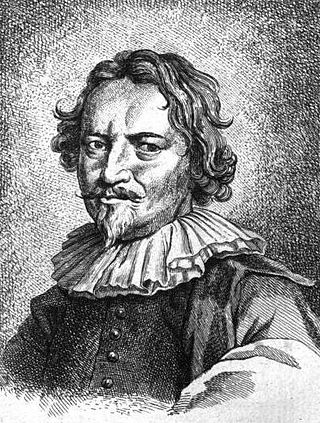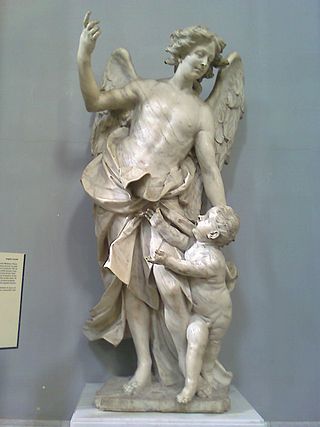
Abbiategrasso, formerly written Abbiate Grasso, is a comune and town in the Metropolitan City of Milan, Lombardy, northern Italy, situated in the Po valley approximately 22 kilometres from Milan and 38 kilometres from Pavia.

Carlo Fontana (1634/1638–1714) was an Italian architect originating from today's Canton Ticino, who was in part responsible for the classicizing direction taken by Late Baroque Roman architecture.

Cosimo Fanzago was an Italian architect and sculptor, generally considered the greatest such artist of the Baroque period in Naples, Italy.

Ferdinando Fuga was an Italian architect who was born in Florence, and is known for his work in Rome and Naples. Much of his early work was in Rome, notably, the Palazzo della Consulta (1732–7) at the Quirinal, the Palazzo Corsini (1736–54), the façade of the Santa Maria Maggiore (1741–3), and the Church of Sant'Apollinare (1742–8). He later moved to Naples and notably designed the Albergo de'Poveri (1751–81), the façade of the Church of the Gerolamini, and that of the Palazzo Giordano.

Atessa is an municipality in the province of Chieti, Abruzzo, south-eastern Italy. It is part of the Val di Sangro mountain community. It is the largest municipality in the province by extension and eighth by population.

Lorenzo de Caro was an Italian painter, active in the late Baroque style in his native city of Naples.

Civitella del Tronto is a town and comune in the province of Teramo, within the Abruzzo region of central Italy. It is in the Gran Sasso e Monti della Laga National Park. It is one of I Borghi più belli d'Italia.

Domenico Antonio Vaccaro was an Italian painter, sculptor and architect. He created many important sculptural and architectural projects in Naples. His later works are executed in an individualistic Rococo style.

Santa Caterina a Chiaia is a Roman Catholic church located on via Santa Caterina 76 in Naples, Italy. It is located near Piazza dei Martiri in the Chiaia section of the city, near where Via Santa Caterina flows toward the tree-shaded Via Chiaia.

Chiaia is an affluent neighbourhood on the seafront in Naples, Italy, bounded by Piazza Vittoria on the east and Mergellina on the west. Chiaia is one of the wealthiest districts in Naples, and many luxury brands have shops on its main street. It is also home to a business school and a medical school, as well as other public schools.

The Villa Spedalotto is the country home of the Paternò di Spedalotto family. The villa is situated on a hill surrounded by olive groves at Bagheria, near Palermo in Sicily. As all the Villas in Bagheria, it was built as a country house, and was traditionally used by the family only during the spring and autumn. While considered a national monument, it remains a private residence.

Christianity and religion in general has always been an important part of the social and cultural life of Naples. It is the seat of the Archdiocese of Naples, and the Catholic faith is highly important to the people of Naples and there are hundreds of historic churches in the city. The Cathedral of Naples is the most important place of worship in the city, each year on September 19 it hosts the Miracle of Saint Januarius, the city's patron saint. In the miracle which thousands of Neapolitans flock to witness, the dried blood of Januarius is said to turn to liquid when brought close to relics said to be of his body: this is one of the most important traditions for Neapolitans.

The Riviera di Chiaia is a long street in the Italian city of Naples, running along the coast of the Gulf of Naples.

Santa Maria in Calanca Castle is a tower in the municipality of Santa Maria in Calanca of the Canton of Graubünden in Switzerland. It, along with the neighboring Church of the Assumption of St. Mary, are both Swiss heritage sites of national significance.

The Church of the Immacolata e San Vincenzo and its adjacent convent, are religious buildings in piazzetta San Vincenzo of the Rione Sanità of Naples, Italy.

Sant'Orsola a Chiaia is a church in largo Sant'Orsola in the quartieri of Chiaia in Naples, Italy.

Santa Maria della Mercede a Montecalvario is a church located on largo Montecalvario in Naples, Italy.

Santa Maria Egiziaca a Forcella is a Baroque-style, Roman Catholic church located in the quartiere di Forcella, in the city of Naples, Italy;

Santa Teresa a Chiaia is a Baroque church in Naples, Italy.
Arcangelo Guglielmelli was an Italian architect and painter, active in his native Naples, Italy, in a late-Baroque style. He was involved in the building and reconstruction of churches, many of which had been damaged by the earthquakes of 1688 and 1694.





















